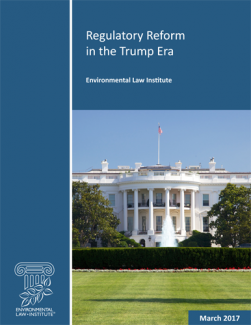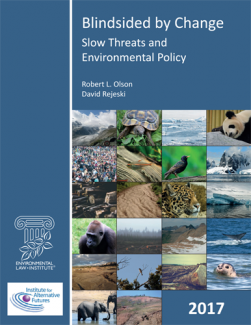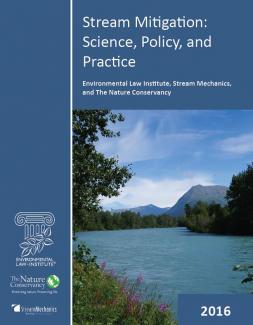Floodplain Buyouts: Following 2017’s monster storms, reports aid communities in acquiring and rehabilitating properties.
2017’s extreme hurricane season is a reminder that such storms are the new normal. Communities will need to become resilient to consequences. ELI can help.
In the aftermath of floods and major storms, property owners are faced with a tough choice — to stay and rebuild in place or leave and rebuild on higher ground. An incentive for homeowners is to participate in a floodplain buyout program, such as the voluntary Federal Emergency Management Agency mitigation buyout program or state or local floodplain acquisition programs for destroyed homes and neighborhoods.
Once properties are acquired through these programs and existing structures removed, the land is typically dedicated to open space or recreational or wetland-management uses. Local governments often take ownership, but they have neither funding nor guidance on what to do with the properties over the long term. The result is that key opportunities are missed to leverage the environmental and flood-mitigation benefits of these properties.
Since 2013, ELI and the University of North Carolina Institute for the Environment have worked to increase knowledge and provide guidance to local governments and communities on how to use buyout programs to maximize the environmental and flood-mitigation benefits of acquired properties.
Building on our expertise, at the end of 2017 ELI and UNC released two guidance documents for local governments and communities. The first guide, Prioritizing Future Floodplain Acquisitions: Maximizing Opportunities for Habitat Restoration, Community Benefits, and Resilience, provides ideas for planning floodplain acquisitions and related projects in order to maximize community benefits. While buyouts are primarily intended to address flood damage to communities in the short term and mitigate future risks, secondary, longer-term benefits can include restoring habitat, rehabilitating ecosystems to improve water quality, and creating recreational spaces. By prioritizing eligible future buyouts, communities can develop more comprehensive mitigation projects and broaden their options for the management and use of acquired properties.
The ELI-UNC report provides a summary of prioritization criteria and methods that communities are using to make the most of these buyouts today, along with a four-step outline for integrating broader community goals into hazard mitigation and acquisition planning.
The second guide, Financing and Incentives Guide for Floodplain Buyouts, focuses on how local governments and communities can fund the acquisition and management of damaged properties.
The primary federal sources of funding for acquisitions are often only available after declared disasters, and often are not sufficient to purchase all eligible properties from willing sellers. Further, federal acquisition programs are usually matching funds for buyout projects provided by state and local governments or other entities. As a result, there are often more property owners willing to sell than are funds available.
Funding also represents a major challenge to managing and restoring properties to successfully leverage all the benefits of floodplain buyouts. Because of these challenges, most acquired properties remain as vacant, unimproved lots.
While available funds vary by state and locality and can depend on budgets, some communities have found creative ways to fund acquisition and management of open space properties. Based on a review of innovative approaches to make floodplain acquisitions a reality, ELI and UNC provide an overview of the sources and types of funds that exist and how they can be used to contribute to acquisition projects. The analysis offers a concise summary of how to approach this critical component of a successful buyout project.
Restoration in Gulf of Mexico Can Continue Despite Funding Cuts
In 2017, ELI released a background paper on Fast-Tracking ‘Good’ Restoration Projects in the Gulf of Mexico, which focused on mechanisms available to speed restoration projects that are subject to federal environmental requirements. The Institute’s research indicated that as the pace of restoration accelerates, resource constraints are likely to become a barrier to timely action and efficient environmental compliance.
ELI recently published a follow-up to that work, addressing this resource deficiency conundrum. Fast-Tracking Restoration: Addressing Resource Constraints in Federal Agencies focuses on how agencies may be able to supplement their internal budget and personnel resources in order to increase the efficiency of the compliance process.
In general, federal agencies can only expend funds allocated to them through the congressional appropriations process. There are exceptions. ELI’s guide explains the circumstances in which federal agencies are allowed to accept outside funds or share personnel with other entities. Appropriately applied, these provisions may assist federal agencies overseeing gulf restoration in addressing at least some of their resource constraints related to environmental compliance.
The backgrounder explores legal provisions to allow government agencies to accept non-federal funds that can be used to expedite activities related to permitting and other environmental compliance activities, and it highlights mechanisms for intergovernmental transfer or loan of personnel engaged in environmental compliance activities to increase capacity without expending funds.
The backgrounder reviews hiring third-party contractors to prepare documents required for federal permits, approvals, or funding, paid for by the applicants, in place of agency review.
Finally, the report suggests attendance at non-profit training activities by government employees involved in environmental compliance activities, where those needs are not already being met.
ELI also provides examples of instances in which these provisions have been used in projects.
By being strategic about the use of existing resources and creating new ones, federal agencies may be able to move restoration projects forward at the rate necessary to rehabilitate the environment and livelihoods of gulf communities.
Senator gives roadmap for environmental justice at ELI event
Last fall, Senator Cory Booker (D-NJ) and Representative Raul Ruiz (D-CA) introduced the Environmental Justice Act of 2017. The bill would require federal agencies to address environmental justice through agency actions and permitting decisions, and strengthen legal protections against environmental injustice for communities of color, low-income communities, and indigenous communities. The measure is the culmination of a months-long process of working with dozens of grassroots organizations across the country to craft a comprehensive bill that strengthens environmental justice protections for vulnerable communities.
ELI hosted a panel discussion co-sponsored by the ABA Section of Civil Rights and Social Justice’s Environmental Justice Committee, the ABA Section of Environment, Energy, and Resources’ Special Committee on Environmental Justice, and Beveridge and Diamond, P.C.Booker gave the keynote address, focusing on the various ways the bill addresses critical issues for vulnerable communities nationwide.
He highlighted the connection between social justice issues and environmental problems. Booker started his career as an activist for issues of poverty, but saw “unconscionable” harm to the environment in his own backyard, such as lead contamination and water pollution, that stemmed in part from racism and disadvantage.
“I didn’t become an environmentalist because I was worried about global warming,” he said. “I didn’t become an environmentalist because I was concerned about penguins or polar bears. I became an environmentalist because I was living in Newark,” where environmental problems were disproportionately cast on disadvantaged communities.
Following the senator’s address, the cosponsors held a discussion with Mustafa Ali, vice president of climate, environmental justice, and community revitalization for the Hip Hop Caucus and formerly head of the EPA’s Office of Environmental Justice, and Patrice Simms, vice president of litigation for Earthjustice.
The program was moderated by B&D’s Randy Hayman.Topics included changes at EPA’s Office of Environmental Justice, attempts to limit science in agency decisionmaking, and challenges to environmental protection for clean air, water, and land via measures that could curtail citizen suits and enforcement.
Field Notes: China grants ELI premier elite NGO advisor status
ELI has received approvals from China’s Ministry of Environmental Protection and the Beijing Bureau of Public Security to begin work on a project to build the capacity of NGOs to more fully engage in environmental litigation. The project is supported by the Hewlett Foundation and the Tilia Fund.
Chinese law grants authority to NGOs to file these types of suits. ELI will work with its local partner, the China Environmental Protection Foundation, to build the capacity of public interest groups in China to file and win environmental cases, ensuring accountability and improvements in environmental quality. With this final procedural step in place, ELI cohosted its first workshop in January.
Receiving this approval is a major reflection on ELI’s international reputation in promoting effective environmental governance and rule of law, as ELI is the first foreign NGO to receive temporary registration for an environmental protection-related project from the MEP under China’s foreign NGO law. It is also demonstrative of the excellent work of CEPF.ELI expects to receive additional temporary registration with other China-based partners to further expand the Institute’s growing work with governmental agencies and others in China.
ELI expects to receive additional temporary registration with other China-based partners to further expand the Institute’s growing work with governmental agencies and others in China.
❧ ELI Visiting Scholar Carol Adaire Jones moderated a session on Tackling Wasted Food With Smart Technology hosted by the Solid Waste Association of North America. The session brought together speakers from organizations and companies that employ new and innovative uses of smart technologies to reduce food waste. The session focused on issues surrounding EPA’s Food Recovery Hierarchy of reduction (preventing wasted food at the source), reuse (donating wasted food leftovers) and recycling (as energy or nutrient products following processing).
❧The Antiquities Act grants presidents the authority to protect historic landmarks, structures, and objects of historic or scientific interest, and restrict uses of that land accordingly. The statute is ambiguous, however, as to whether the authority to reduce or modify these national monuments rests with Congress or the President — and the courts have never ruled on this particular issue.
Yet, last April, more than 50 years since the last alteration of national monument boundaries, President Trump issued an executive order instructing the Interior Department to undertake a broad review of national monuments created since 1996 that are larger than 100,000 acres. Based on the review, two proclamations significantly reduced the perimeters of Grand Staircase-Escalante and Bears Ears national monuments.
ELI explored these legal questions at an ELI Associates Seminar, Antiquities Act: Legal Implications for Executive and Congressional Action. Speakers explored issues surrounding presidential authority and the role of Congress in the declaration and modification of national monuments. Participants gained insight into the legal history of the law, importance of America’s national monuments, and the role of Congress in management of these lands.


 The Renewable Fuels Association has hired Jessica Bennett as vice president of external affairs. She comes to the association from the National Corn Growers Association.
The Renewable Fuels Association has hired Jessica Bennett as vice president of external affairs. She comes to the association from the National Corn Growers Association. Boutique firm EKM Law PLLC welcomes Bicky Corman to its Washington, DC, office. Corman is a former EPA deputy general counsel.
Boutique firm EKM Law PLLC welcomes Bicky Corman to its Washington, DC, office. Corman is a former EPA deputy general counsel. Beveridge & Diamond PC has scored the Obama administration’s top environmental lawyer for their firm. John Cruden enters private practice after serving as assistant attorney general of DOJ’s Environment and Natural Resources Division. Cruden is also former president of the Environmental Law Institute.
Beveridge & Diamond PC has scored the Obama administration’s top environmental lawyer for their firm. John Cruden enters private practice after serving as assistant attorney general of DOJ’s Environment and Natural Resources Division. Cruden is also former president of the Environmental Law Institute. Alexandra Dapolito Dunn has been appointed EPA Administrator for Region 1, which oversees environmental protection efforts in much of the Northeast. Dunn previously served as executive director and general counsel for the Environmental Council of States. She is also a former board member of the Environmental Law Institute.
Alexandra Dapolito Dunn has been appointed EPA Administrator for Region 1, which oversees environmental protection efforts in much of the Northeast. Dunn previously served as executive director and general counsel for the Environmental Council of States. She is also a former board member of the Environmental Law Institute. The White House nominates Frank Fannon as assistant secretary of state for energy resources. Fannon is an energy consultant and longtime Senate staffer.
The White House nominates Frank Fannon as assistant secretary of state for energy resources. Fannon is an energy consultant and longtime Senate staffer. Sarah King, a former ELI research associate, transitions from corporate life to her new position as project manager at Climate Mayors. She joins the group from DuPont, where she served as manager of climate and sustainability.
Sarah King, a former ELI research associate, transitions from corporate life to her new position as project manager at Climate Mayors. She joins the group from DuPont, where she served as manager of climate and sustainability. The Indiana University Robert H. McKinney School of Law appoints Janet McCabe, former EPA Clean Air administrator, as a professor of practice.
The Indiana University Robert H. McKinney School of Law appoints Janet McCabe, former EPA Clean Air administrator, as a professor of practice. Miles & Stockbridge continues its expansion in Washington, DC with the addition of Russell V. Randle, who joins the firm from Squire Patton Boggs.
Miles & Stockbridge continues its expansion in Washington, DC with the addition of Russell V. Randle, who joins the firm from Squire Patton Boggs. Former ELI Executive Vice President Scott Schang joins the Seattle-based NGO Landesa as senior director of corporate engagement. Schang had previously served as editor in chief of the Environmental Law Reporter.
Former ELI Executive Vice President Scott Schang joins the Seattle-based NGO Landesa as senior director of corporate engagement. Schang had previously served as editor in chief of the Environmental Law Reporter. Moving from government service to the private sector, Christopher Smith, former Department of Energy assistant secretary for fossil energy, joins liquefied natural gas producer and exporter Cheniere Energy Inc.
Moving from government service to the private sector, Christopher Smith, former Department of Energy assistant secretary for fossil energy, joins liquefied natural gas producer and exporter Cheniere Energy Inc. Bringing expertise from an international law firm and the Sabin Center for Climate Change Law at Columbia University, Marne S. Sussman joins as a partner in Holland & Knight’s San Francisco West Coast Land Use and Environment Group.
Bringing expertise from an international law firm and the Sabin Center for Climate Change Law at Columbia University, Marne S. Sussman joins as a partner in Holland & Knight’s San Francisco West Coast Land Use and Environment Group. Former top White House aide to President Obama Heather Zichal takes over as managing director of corporate engagement at The Nature Conservancy.
Former top White House aide to President Obama Heather Zichal takes over as managing director of corporate engagement at The Nature Conservancy.




